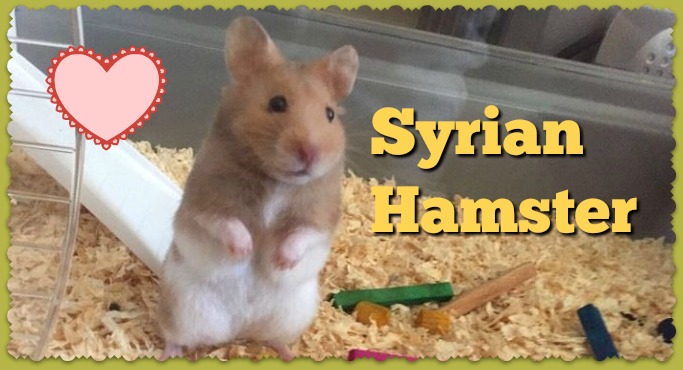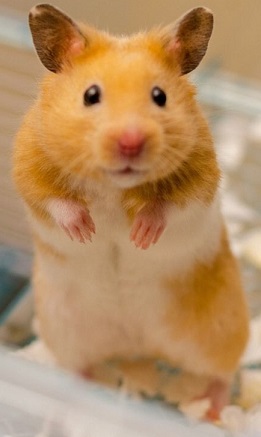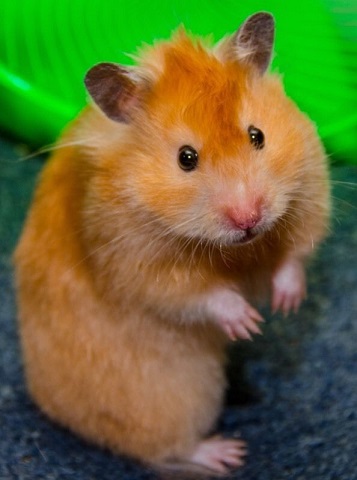
Larger than Dwarf Hamsters, The Syrian hamster – also known as the Golden or Teddy bear hamster is a small rodent belonging to the Cricetinae family. Syrian hamsters have rapidly become very popular household pets in the western world ever since Professor Aharoni captured a female hamster and her 12 pubs in Aleppo Syria back in 1930.
Indeed – All Syrian hamsters that are available as pets can trace their ancestry back to this captured female. The Louisiana Veterinary Medical Association has stated that Syrian hamsters were introduced to North America in 1936 and were some of the first domesticated pet hamsters.
As their name suggests, these critters are native to Syria and parts of Israel; however, Syrian hamsters have been found in other regions of the Middle East.
Contents
- 1 Description – What does a Syrian Hamster Look Like?
- 2 Life Span – How long does a Syrian Hamster Live?
- 3 “Teddy Bear Hamster”
- 4 Care – Basic Syrian Hamster Care
- 5 Food – What do Syrian Hamsters Eat?
- 6 Housing – The Best Cage for a Syrian Hamster
- 7 Coats – The Different Types Of Syrian Hamster Coat
- 8 Common Coat Colors of Syrian Hamsters
- 9 Patterns – Common Fur Patterns of Syrian Hamsters
- 10 Syrian and Dwarf Hamster Differences
- 11 Resources
Description – What does a Syrian Hamster Look Like?

Syrian Hamster
Syrian Hamsters are small rodents about the size of an adult human hand – The adult size ranges from 5 – 7 inches in length. They typically weigh around 120 to 125 grams when fully grown. They have a stout, stocky body with little tails that are barely visible underneath their fur. They have small fur covered ears and short, stocky legs with wide feet.
Hamsters have large eyes and small tulip shaped ears. The original wild color of the hamster is golden brown hence their name as the ‘Golden Hamster.’ The most notable characteristic of the Syrian hamster is its ability to store food in two cheek pouches.
Syrian hamsters are excellent pets for people of all ages particularly children. They are naturally docile and easy to tame. Handling them is a joy as they are quite slow movers and their size makes them a perfect handful.
Unlike the dwarf species, Syrians are strictly solitary animals and must be housed on their own. If you keep Syrian Hamsters together, there is a high risk that they would adversely injury or even kill each other. Even if they do not display signs of aggression to each other, they will most certainly be stressed out and unhappy being forced to live with another adult – It is not recommended to keep them caged near to each other for this reason. Syrians can live with their brothers and sisters up until around the age of 5 weeks and then they must be found new homes or housed in separate cages.
Syrian hamsters are nocturnal animals making them spend most of the daylight hours in their nest sleeping. They become active in the evening and at night time which means they make great pets for those who are at work or school during the day time and want to have some hamster bonding time during the evening.
Syrians might not make ideal pets for young children who go to bed early.
Life Span – How long does a Syrian Hamster Live?
Before buying any pet, it is a good idea to have an idea of their life span. You can expect an average healthy hamster to have a life expectancy from 2 to 3 years.
In the wild, they tend to have shorter lives. The oldest Syrian Hamster on record lived to the ripe age of 6 and a half. Many factors affect a hamsters life span, they include;
- Quality of care
- Genetics
- Diet & Nutrition
- Exercise
- Sickness
- Housing environment
It is safe to assume that if you take excellent care of your hamster, they will live to the greatest of their genetic potential.
“Teddy Bear Hamster”

If you live in the USA or many American hamster forums, you may come across terms like “fancy bear hamster,” “black bear hamster,” “teddy bear hamster” and much more. These are NOT species of hamster! They are names given to certain coloration’s and patterns by pet stores, and these names have become popular and propagated across the internet.
Black Bears are just Syrian hamsters with black fur. This practice is also applied to Dwarf hamsters – often describing dwarfs as “blackberry or pudding hamsters.”
Care – Basic Syrian Hamster Care
Basic Syrian hamster care is not complicated, and there are no excuses not to take care of your hamster. They are quite easy to look after and can become tame with daily handling. Syrians are solitary animals but are social and docile towards human owners. To avoid an unhappy hamster be sure to spend time with them every day and give them a large selection of toys to entertain them. Some good cheap hamster toys and chews include cardboard boxes, toilet roll tubes, and cereal boxes. It is rare for a Syrian hamster to bite its owner, and they tend to react well to frequent handling.
Do not wake your hamster up as it will startle them and you may get a negative response. Hamsters are clean animals and will tend to choose a corner of their cage furthest from their nest to urinate and defecate therefore they do not need a whole cage clean out very frequently.
Food – What do Syrian Hamsters Eat?
When it comes to your pet Syrian hamsters nutrition, you should base their diet on a high-quality commercial hamster mix. There is a huge range of brands, and it can be a daunting task choosing your hamster food.
A good hamster mix should contain a right combination of seeds, grains, and nuts with nutritional balance of roughly – 12-15% protein and 3-6% fat. Pregnant hamsters should get extra protein and fat while they are expecting and nursing.

You can supplement your hamster with fresh fruit and vegetables. Favorites include Applies, Carrots, Broccoli, Pears, and Cabbage. Avoid citrus fruits as they are too acidic.
You should make sure not to feed fresh food every day because hamsters like to hoard food in their nests. Excess fruit and veg can also cause stomach upsets and diarrhea. Wash any food to remove any pesticides harmful to your pet. Be sure to remove any uneaten fresh food after 24 hours to prevent them from eating spoiled food.
All species of hamsters have cheek pouches which, in the wild are used to transport food into their burrow. Hamster owners often mistakenly judge their hamster’s food intake because they do not take into account the food that has been hoarded away!
Treats – Treating your Syrian Hamster
You can give your hamster treats once or twice a week to provide some extra protein. Hamsters love treats, but you should not over feed them. Sugar-Filled shop bought treats such as ‘honey sticks’ are often very unhealthy in large quantities. Some examples of healthier treats to feed your hamster includes;
- Some hard boiled egg white
- Cottage Cheese
- Small amounts of Timothy hay
- Sunflower Seeds & Peanuts (Give very sparingly as they are high in fat)

Housing – The Best Cage for a Syrian Hamster
Syrian hamsters are solitary animals and need to be on their own from 4-5 weeks of age. There are a few different options for housing your pet hamster, with hamster cages being the most popular. All hamsters should have a spacious environment with plenty of bedding/substrate to dig in as they are burrowing animals in the wild.
Bigger is ALWAYS BETTER
Studies have proven that small and cramped surroundings can make a pet hamster chronically stressed, so it is important to give them a large environment. Hamsters need at least 10,000 square cm of floor space.
The cage must be high enough for them to rear up on their hind legs with a minimum of 6 inches. Hamsters kept in small cages are far more likely to exhibit signs of boredom, more commonly – gnawing on cage bars.
More information: Behaviour of golden hamsters (Mesocricetus auratus) kept in four different cage sizes- K Fischer, SG Gebhardt-Henrich and A Steiger
You should provide your hamster with:
Substrate – Critical to soak up urine and provide material for digging and burrowing. Good examples include wood shavings (from safe woods) and paper-based substrate such as Carefresh.
Bedding – Hamsters need bedding to build nests and to keep them warm while asleep. If you give them paper based substrate like Carefresh, they can also use this as bedding. Another cheaper option is shredded up toilet tissue is an excellent material. You should never use cotton wool or similar material for nesting as it can choke your hamsters and causes blockages if they attempt to swallow it.
Exercise Wheel – Fully grown Syrian hamsters require a wheel with a diameter of a minimum of 8 inches. Anything smaller will cause your pet to arch their back potentially causing health issues. Some hamster cages already come with a hamster wheel that may or may not be suitable for your pet.
Water Bottle – Much more preferable to water bowls as your hamster’s water supply is safe from being soiled or tipped over. Make sure you refill it every day and monitor it for dripping.
Food Bowl – Your hamster should have a large bowl to prevent them from tipping it over. Ceramic and stainless steel are ideal materials as they are hygienic and cannot be chewed up.
Chews / Gnaws – Hamsters are like all other rodents and have teeth that are continuously growing. It is important to give them wooden chews to help them keep their teeth trim.
Treats – Hamsters love treats now and then to keep them happy.
Toys – Hamsters need toys to keep them from getting bored. It is vital to give them mental stimulation and exercise to keep them happy and distract them from feeling trapped.
Coats – The Different Types Of Syrian Hamster Coat
The first hamsters discovered had short hair, since thenn fancy breeders have managed to breed four different coated types. Shorthaired, Longhaired, Satin and Rex.
 Long Haired – Commonly referred to as ‘Teddy Bear’ or Angora Hamsters have longer fur than usual. Only male hamsters can develop a long coat, often reaching the length of 3 or 4 inches. Male long haired Syrians have a ‘skirt’ effect around their bottom section whereas females just have a ‘fluffy all over’ look.
Long Haired – Commonly referred to as ‘Teddy Bear’ or Angora Hamsters have longer fur than usual. Only male hamsters can develop a long coat, often reaching the length of 3 or 4 inches. Male long haired Syrians have a ‘skirt’ effect around their bottom section whereas females just have a ‘fluffy all over’ look.
Long Haired Hamsters need attention when kept as pets because their fur becomes matted and tangled up easily as well as attracting individual substrates to sticking. Hamster owners can give their long coats a gentle grooming with a toothbrush or a small flea comb.
Satin – Satin Syrians are beautiful animals with a glossy sheen to their coats. Some of the fur shafts are hollowed out which gives an ultra-shiny look. Breeding two Satin hamsters together is not recommended as the results are not favorable creating offspring with greasy, thin fur.
Rex – Relatively new to North America – Rex Syrians have been common in Europe for many years. Their biggest characteristic is their curly, crimped wavy coat. Their coats are typically very short and dense.
Common Coat Colors of Syrian Hamsters
Fancy hobby breeding has managed to produce hamsters with vastly differing coats with lots of different patterns, colors, and fur lengths.
Syrian hamsters can come in many different colors including, gray, black, yellow, red or a mixture of several different colors.
Beige – Produced by breeding a two hamsters with the rust and dark gray genes, the beige color variety is often the smallest and less robust of the litter.
Beige hamsters sometimes have a kinked tail. It is inadvisable to breed two closely related beige hamsters as it is such a rare color, finding unrelated animals is difficult.
Black – In the UK, back in 1991, the Black Bear Hamster was introduced. Black bear hamsters typically have very dark jet black fur which extends right down to the roots. The black color is uniform all over their bodies with some hamsters exhibiting white color on their belly and paws.
Cream – There are three variations of cream hamster – black eyed, red-eyed and ruby eyed. The cream variety coat coloration ranges from orangey-cream to a sandy color. Black-eyed creams often have dark gray ears, but this is not often the case. Red-eyed creams have pale ears.
Sable – Often mistaken for black hamsters, the sable variation has a black topcoat and an undercoat of ivory cream. They have black belly fur, black eyes, and gray ears. The Ivory cream coat immediately surrounds their eyes.
White – The white variety comes in three different types – flesh and dark eared and black eyed. All three categories have completely white coats. First discovered in 1952, the dark-eared variation has red eyes that turn darker as the hamster ages. Flesh eared variation hamsters are commonly named albinos.

Patterns – Common Fur Patterns of Syrian Hamsters
Banded – A very typical pattern found at pet stores and breeders, a banded hamster typically has a band of white fur around their mid-section. Most color variations can have the band trend. The band width is variable.
Dominant Spot – In 1964 the dominant spot was first discovered in the USA and rapidly became more popular than the piebald because it was easy to breed. By UK and US standards, this hamster is commonly described as a “white hamster with colored spots.”
Piebald – Another familiar pattern you will most likely find in pet stores, the piebald hamster has a colored coat dotted with white spots all over. The spots can be small and few or can cover the whole body. Piebalds can sometimes have bellies with different color as well. Piebalds are difficult to breed and are considered to be close to extinction by some in the hamster community.
Tortoiseshell – Tortoiseshell hamsters are two colored animals with two primary color tones in their coat. One of these colors is always yellowy, and the patches are distinct with no bridling. Only female hamsters can be the tortoiseshell variant because the gene is linked to the female sex.
Tortoiseshell and White – The same as a tortoiseshell except they have a white band and a white belly. Again, females can only be this variant because of the female-linked gene.
Roan – Roan hamsters look very similar to white hamsters, but they have coloration splattered around the head area which gradually dissipates towards the rear.
Syrian and Dwarf Hamster Differences
Both Dwarf and Syrian hamsters make excellent pets. Here are the key differences between the two species.
- Syrians are larger than Dwarf Hamsters.
- Syrians come in a multitude of patterns and colors compared with Dwarfs. They can also be long or short haired.
- Syrians are solitary animals, whereas dwarfs can live together.
- Syrians can remain tame, even when ignored for a few days. Dwarf Hamsters need constant attention to stay tame.
